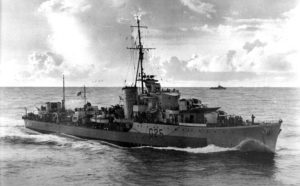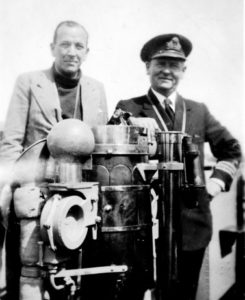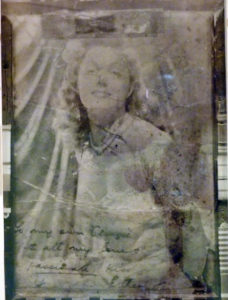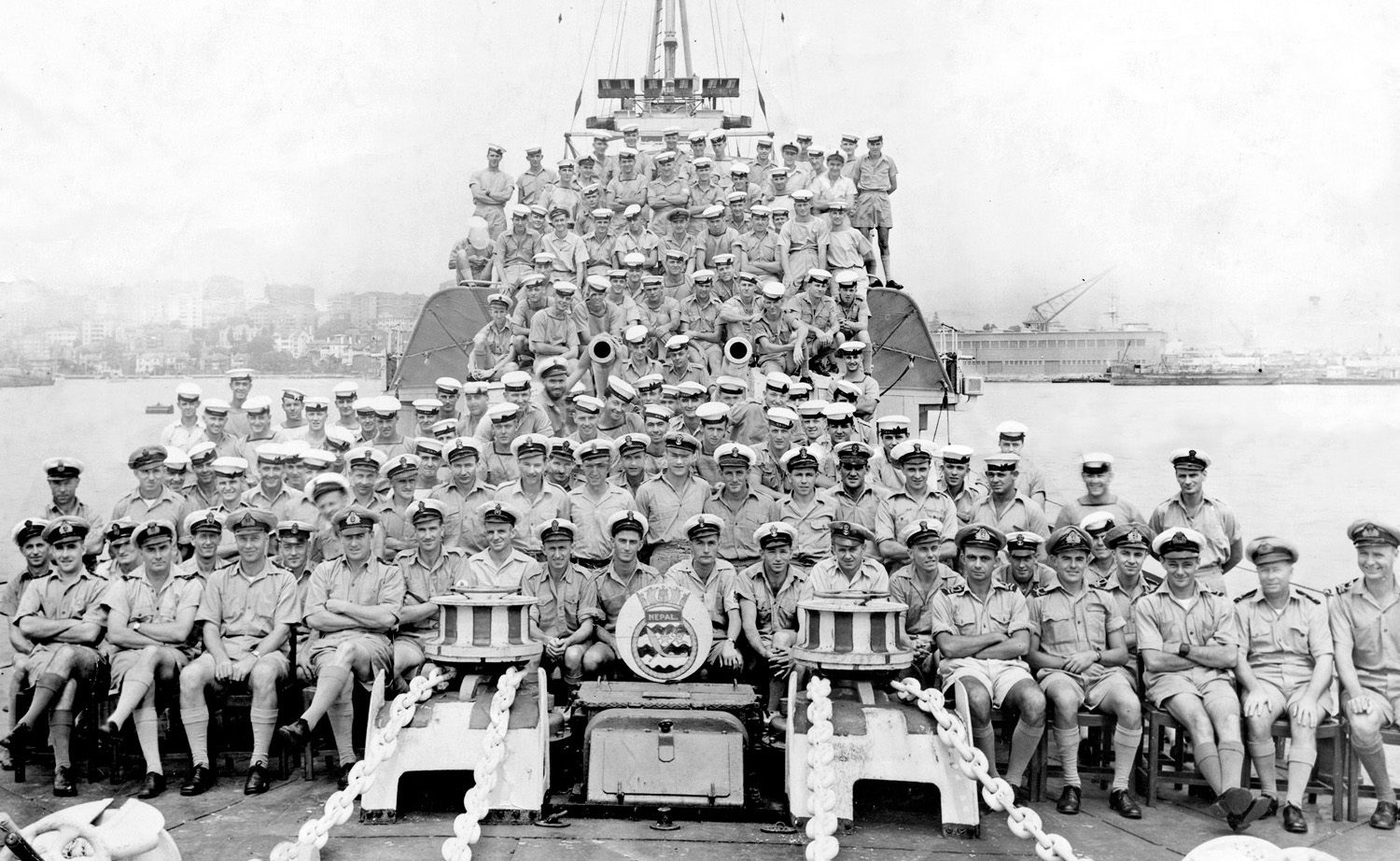By Commander Greg Swinden RAN
HMAS Nepal was one of eight N Class destroyers laid down in British shipyards during 1939 for service in the Royal Navy. Five of these (Napier, Nestor, Nepal, Nizam and Norman (I)) were transferred to the Royal Australian Navy while two went to the Royal Netherlands Navy and one to the Polish Navy. Only one, HMAS Nestor, was lost when sunk by German air attack in the Mediterranean on 16 June 1942.
The destroyer was originally laid down as Norseman at the Thornycroft & Co Ltd shipyard in Southampton on 9 September 1939 and was originally allotted to the Royal Netherlands Navy. In December 1940 the shipyard was badly damaged by a German air raid and Norseman was struck by a bomb which almost cut the hull in two. Norseman was repaired but this delayed her launching and another of the N Class was allocated to the Dutch. The ships name was also then changed to Nepal and she was launched on 4 December 1941 and subsequently commissioned on 11 May 1942 under the command of Commander Franklyn Morris RAN. Also on-board when the destroyer commissioned was the ships mascot ‘Major’ a male bull terrier who wore a special Navy blue ceremonial coat with various naval rank badges sewn on it. ‘Major’ stayed with the ship until early 1943 when he had to be left behind in South Africa when the destroyer returned to Australia.
HMAS Nepal was the last of the Australian N Class destroyers to commission and began her war service with the Home Fleet at Scapa Flow undertaking anti-submarine exercises in early June. During 14-15 June Nepal, in company with HM Ships Ashanti and Wilton conducted an anti-submarine patrol from Scapa Flow to the Faroe Islands. Nepal operated in the North Sea, during 29 June – 2 July 1942, as part of a ‘decoy’ convoy attempting to lure German forces south while convoy PQ.17 was commencing its journey to north Russia.

The decoy convoy was not spotted by German forces and Nepal was detached and steamed to the Thornycroft & Co Ltd shipyard builder’s yard, in Southampton, arriving on 4 July to repair defects that had arisen since commissioning. It was during this time that Nepal was used by Two Cities Films to represent the fictional destroyer HMS Torrin in the British war film In Which We Serve, starring Noel Coward. The film was based on the exploits of HMS Kelly while under the command of Coward’s friend Lord Louis Mountbatten.

On 17 July Nepal departed British waters as part of the escort for Convoy WS.21P. This was a significant convoy carrying troops, vehicles and equipment, for the 8th Army in North Africa, and was routed around the Cape of Good Hope to reduce the risk of enemy air and submarine attack in the Mediterranean. The convoy reached Freetown, Liberia on 27 July and after refuelling sailed on 2 August. The following day a U-Boat attacked the convoy but was unsuccessful and Nepal was involved in dropping depths charges to frustrate the attacking submarine. The convoy escaped without loss and the hunt for the U-Boat continued for an hour and half; but without success.
Nepal continued as a convoy escort until WS.21P approached the entrance to the Red Sea. The destroyer was then detached and headed south to Kilindini, the port for Mombasa, Kenya. Arriving there on 25 August she joined her sister ships, Napier, Nizam and Norman as part of the 7th Destroyer Flotilla of the British Eastern Fleet. In early September 1942 she took part in the second phase of the campaign to seize control of Madagascar from Vichy French forces. Operation STREAM saw Nepal, and HMS Fortune, screening the battleship HMS Warspite which was on standby to provide naval gunfire support for British troops landing at Majunga (Mahajanga) in north-west Madagascar. The landing was achieved without the need for naval bombardment. On 19 September Nepal and Fortune, as part of Operation JANE, again provided the destroyer screen for Warspite supporting the landings at Tamatave (Toamasina) on the east coast of Madagascar; but again naval bombardment was not required.
She was then employed escorting convoys between Kilindini and Durban and on anti-submarine patrols off the Cape of Good Hope. Nepal was docked at Simonstown naval base for maintenance in October. In late November Nepal and Fortune conducted a search for survivors from the US cargo ship SS Pierce Butler that had been sunk east of Durban by a U-Boat. All 62 crew-members, in four lifeboats, were located and taken to Durban by HMS Fortune. During December Nepal took part in exercises with Commander Morris performing the duties of Captain (Destroyers) for the Eastern Fleet and escorting the battleships HM Ships Valiant and Warspite and the aircraft carrier HMS Illustrious.
Convoy escort and general fleet duties kept Nepal fully occupied through the first two months of 1943. This included Operation PAMPHLET, in February 1943, escorting the troopships carrying the Australian 9th Division from the Middle East to Australia (HMA Ships Nepal, Nizam and Norman were part of the convoy escort from the Maldives to the eastern Indian Ocean where other Allied warships took over). On 19 March 1943 Nepal departed Durban heading east to Australia and while en-route sailed through a severe cyclone between Mauritius and Diego Garcia. She suffered notable damage to her upper deck fittings and boats and minor injuries to her ships company.
After refuelling at Diego Garcia, from RFA Appleleaf, the destroyer continued her transit to Western Australia arriving at Fremantle on 3 April. After a 24 hour visit to re-fuel she headed eastwards across the Great Australian Bight arriving in Melbourne on 8 April. Nepal sailed the next day and arrived in Sydney on 10 April. She then commenced a refit that lasted until 22 May 1943 and undertook a major change out of personnel. Most of her crew for the voyage home had been serving overseas for some time and had been gathered together from other RAN ships, and sent home for long leave.

In June 1943 Nepal returned to the Indian Ocean and, operating as a unit of the Eastern Fleet, was kept busy with convoy escort and patrol duties for the remainder of the year. It was during this period that the famous Esther Williams[1] Trophy was created on-board by Lieutenants Lindsay Brand and David Stevenson (who went on to be become Vice Admiral Sir David Stevenson, AC, KBE, RAN and Chief of Naval Staff during 1973-76). This framed photo, of the famous actress, went on to become a ‘trophy’ that had to be displayed in the ships wardroom but was fair game for ‘liberation’ and as a result passed through many warships until the trophy was retired from service in 2013.
The 7th Destroyer Flotilla, including Nepal, relocated to Trincomalee, Ceylon (now Sri Lanka) in February 1944 to conduct operations against the Japanese in the eastern Indian Ocean. During 8 – 12 March 1944 Nepal was part of the screening force for Operation INITIAL; a sweep of the Bay of Bengal by the battleship HMS Valiant, battlecruiser HMS Renown and aircraft carrier HMS Illustrious to try and draw out Japanese naval forces for battle; but without success. In late March she supported Operation DIPLOMAT escorting HM Ships Queen Elizabeth, Valiant, Renown and Illustrious during their passage to Fremantle. Nepal then returned to Trincomalee.
On 1 April 1944 Lieutenant Commander John Plunkett – Cole, RAN took command of the ship at Trincomalee. Also serving in Nepal at this time was Petty Officer James Macdonnell (May 1943 – September 1944) who later went on the become the author of many fiction books concerning the RAN in World War II.
In April 1944 Nepal was part of the destroyer screen protecting the carriers USS Saratoga and HMS Illustrious for their air strikes against the Japanese held port of Sabang in Sumatra (Operation COCKPIT). The following month, on 17 May, Nepal was again part of the destroyer screen in the strike against Surabaya in Java (Operation TRANSOM) by aircraft from the same two carriers. These two raids were mainly to distract Japanese forces while Allied amphibious landings took place in New Guinea but the operations also resulted in the destruction of port facilities, fuel supplies, airfields and several Japanese aircraft.
In August 1944 Nepal returned to Australia for a refit which was completed in October. On 8 October 1944 Lieutenant Commander Charles John Stephenson, RAN took command of the destroyer. Lieutenant Commander Plunkett-Cole then briefly commanded HMAS Napier before being promoted commander and taking command of HMAS Norman in late 1944. Nepal returned to the Eastern Fleet on 1 November arriving at Trincomalee in company with Napier. Exercises with British submarines and escorting the aircraft carrier HMS Victorious to Bombay occupied the remainder of November. On 6 December while conducting gunnery practice, with the ships four barrel 2 pounder pom-pom gun, a shell struck the aft funnel guy wire and exploded. Several men observing the shoot were hit by shell fragments and while none were killed several were wounded including three ratings who were disembarked at Chittagong in India (now Chattogram in Bangladesh), for significant surgery.
On 7 December 1944 Nepal joined Napier at Chittagong prior to proceeding to the Arakan coast of Burma to provide naval gunfire support for the 74th Indian Brigade fighting ashore against the Japanese. Nepal began her first bombardment mission on 14 December; conducting an indirect bombardment of enemy positions at Udaung Chaung. This was her first shot fired in anger during the war and the bombardment of Japanese positions continued throughout the remainder of December. Nepal alternated with her sister ship Napier as the fire support destroyer, sailing to Chittagong every third day to replenish stores and ammunition.
In early January 1945 Nepal took part in further operations in Burma; transporting 450 British soldiers and Royal Marine Commandos to Akyab Island and preparing to provide naval gunfire support for the capture of Akyab Island on 3 January. The naval force for this combined operation comprised the cruisers HM Ships Newcastle, Nigeria, and Phoebe and the destroyers Pathfinder, Raider and Rapid as well as Napier and Nepal. The sloops HM Ships Shoreham and Narbada and the Royal Indian Navy HMIS Jumna were also present.
Nepal successfully transferred the troops to assault landing craft on the morning of the 5th but the Japanese withdrawal from Akyab turned the planned assault into a routine landing negating any need for naval gunfire support. On 6 January Nepal left the Burma theatre for maintenance at Colombo, Ceylon (Sri Lanka). The destroyer arrived at Colombo on the 13th and docked the following day. During her time in port a group of the ship’s stokers were arrested for drunken and riotous behaviour in which a Ceylonese native died. The men were left behind in port when Nepalsailed but were later released due to lack of evidence.
On 25 January Nepal returned to Burmese waters to assist with the seizure of Cheduba Island by Royal Marines (embarked in the cruisers HM Ships Kenya, Newcastle and Nigeria). Nepal embarked the Commander-in-Chief, East Indies Fleet, Admiral Sir Arthur Power, who witnessed the operation from her decks. There was only minor Japanese opposition ashore and Nepal took no part in the bombardment.
During early February Nepal resumed an offensive role in the Burma theatre, shelling Japanese positions on Ramree Island. On 5 February she damaged her starboard propeller after striking a submerged rock in the Kaleindaung River. Despite this damage the destroyer continued operating off the Burmese coast until 12 February when she sailed to Colombo for docking. Nepal under-went repairs during 16 – 25 February involving replacement of her badly damaged starboard propeller.
On 1 March 1945 Nepal‘s lengthy service in the Indian Ocean finally came to an end when she departed Trincomalee and steamed to Fremantle escorting the aircraft carriers HM Ships Fencer and Ruler. The destroyer then headed eastwards arriving in Sydney on the 16th for boiler cleaning and maintenance. For the ships service in the Burma campaign Electrical Artificer 4th Class Edward Chapman was subsequently awarded a Mention in Dispatches ‘For gallantry in the face of the enemy while serving in HMAS Nepal’ (London Gazette 1 January 1946).
On 2 April 1945 Nepal sailed from Sydney to join the British Pacific Fleet (BPF) Task Force 57 arriving on the 19th. HMA Ships Napier, Nepal and Norman becoming part of the screening force to protect the British support ships from Kamikaze attack as the BPF was at this stage supporting the US landings at Okinawa. Known as Operation ICEBERG the BPF aircraft carriers conducted daily attacks on the Japanese island of Sakashima Gunto, lying 175 miles to the west of Okinawa. This was to prevent Japanese kamikaze aircraft attacking the large number of US warships and support vessels involved in the actual capture of Okinawa.
Following the significant ship losses and damage, due to Kamikaze attacks, during the Philippines campaign the Allies were taking no chances of the capture of Okinawa being halted due to similar attacks. The aircraft carriers HM Ships Formidable and Illustrious were both damaged by Japanese Kamikaze attacks in April-May 1945. Okinawa was finally captured on 2 July 1945 after an epic 98 day battle and became a US forward operating base for further attacks on mainland Japan. When not screening the larger warships Nepal carried out the unsung duty of ‘Mail Ship’ collecting and distributing mail for the task group.
Nepal arrived at Manus Island on 25 May and in early June steamed south to Sydney. The period 7 – 28 June 1945 was spent in Sydney for maintenance and leave while also exercising with other ships of the 7th Destroyer Flotilla at Jervis Bay. On 28 June the destroyer headed north again bound for Manus Island. While in company with the aircraft carrier HMS Ruler she rescued one of the ships pilots, on 8 July, who had bailed out of his stricken aircraft. Nepal re-joined the BPF, as part of the force screening the British aircraft carriers, tankers and other support ships, on 12 July.
On the last day of hostilities (15 August 1945 when Japan announced her surrender) Nepal was at Manus Island. On 20 August Nepal undertook a short maintenance period in the floating dock at Manus Island before heading north to Japan arriving in Tokyo Bay on 6 September 1945; four days after the surrender ceremony. She then became one of several RAN ships operating in the area enforcing the terms of the surrender.
The destroyer spent five weeks in Japanese waters, mainly at Yokohama, and on 17 September embarked Vice Admiral Sir Bernard Rawlings, GBE, KCB, RN from HMS King George V and conveyed him, and other officers, to Tokyo for the formal re-opening of the British Embassy. Personnel from HMA Ships Shropshire, Quickmatch, Nepaland Norman took part in a march past during the re-opening of the embassy. Nepal departed Japanese waters on 12 October arriving in Sydney on 22 October 1945. Nepal suffered her only death on 19 November 1945 when Lieutenant Hector William Henry Roberts, RANVR, who had been left behind ill in Japan, died and was subsequently buried at Yokohama War Cemetery.
During her service with the Royal Australian Navy HMAS Nepal steamed 224,628 miles and spent 14,274 hours underway. HMAS Nepal decommissioned, at Sydney, on 11 November 1945 and was returned to the Royal Navy who commissioned her, at Sydney, as HMS Nepal on 19 November 1945. She returned to British waters in late 1945 and was subsequently employed as a minesweeping trials vessel at Portsmouth and later at Rosyth. HMS Nepal was decommissioned on 16 November 1950 and placed in reserve; first at Plymouth and then at Penarth. In May 1955 she was sold for scrap and on 16 January 1956 Nepal arrived at Briton Ferry, in South Wales, where she was broken up.
Commanding Officers
Lieutenant Commander Franklyn Bryce Morris, RAN 11 May 1942 – 1 April 1944
Lieutenant Commander John Plunkett – Cole, RAN 1 April 1944 – 8 October 1944
Lieutenant Commander Charles John Stephenson, RAN 8 October 1944 – 11 November 1945

[1] Esther Williams was an American swimming champion who became one of the most popular and profitable Hollywood movie stars of the 1940s and ’50s. Biography




